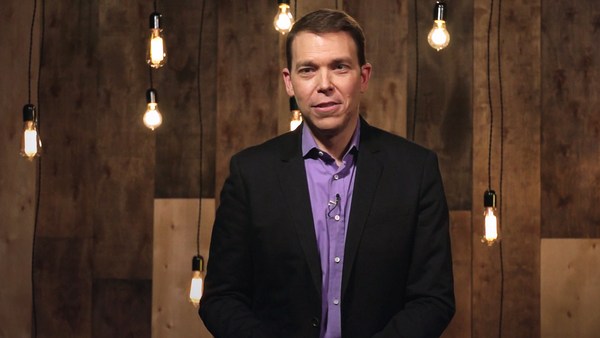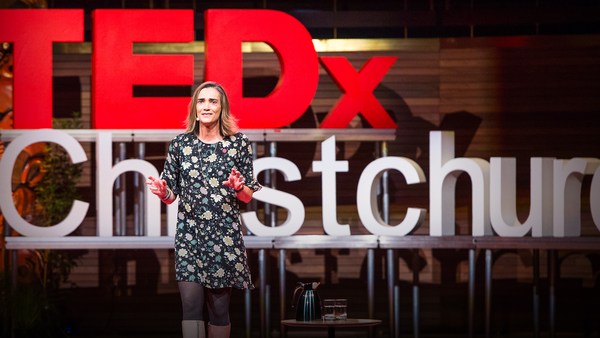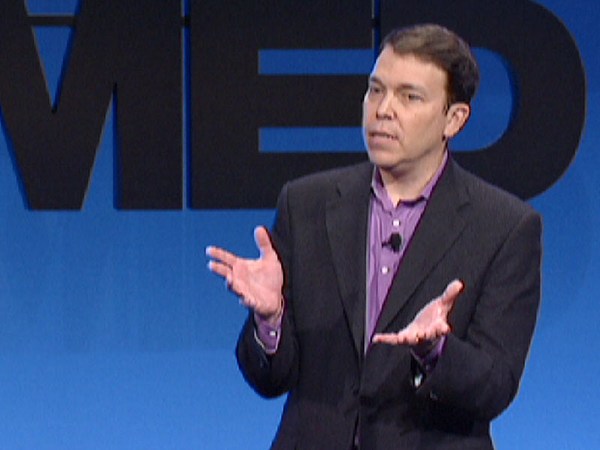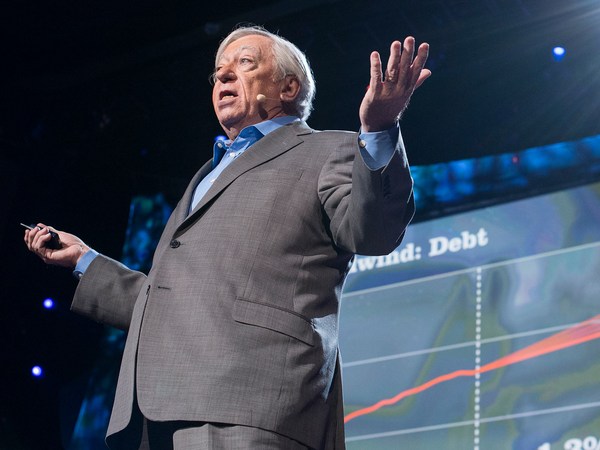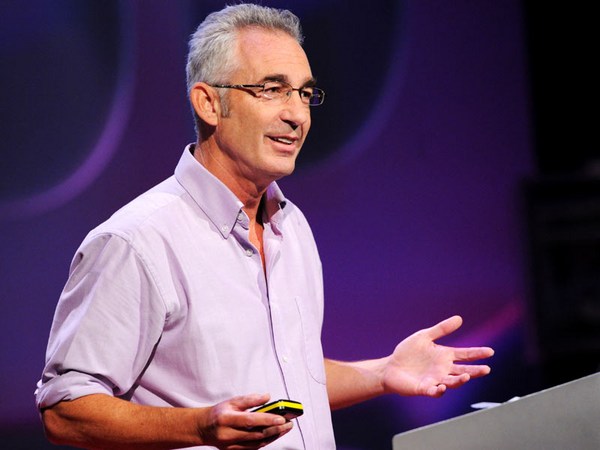I used to have a saying that phone calls don't change your life. Until one day I got a phone call that did. It was from my mother. "Your father is trying to kill himself." He's what? My dad was a son of the American South, a Navy veteran and civic leader, he was never depressed a minute. Until he got Parkinson's. Six times in 12 weeks, my dad attempted to end his life.
We tried every solution imaginable, until one day I had a thought. Maybe my dad needed a spark to restart his life story. One morning I sent him a question. "Tell me about the toys you played with as a child." What happened next changed not only him, but everyone around him, and led me to reimagine how we all make meaning, purpose and joy in our lives. This is the story of what happened next and what we all can learn from it.
I want you to stop for a second and listen to the story going on in your head. It's there, somewhere, in the background. It's the story you tell others when you first meet them, the story you tell yourself every day. It's the story of who you are, where you came from, where you're going. It's the story of your life. What we've learned from a generation of brain research is that story isn't just part of us. It is us in a fundamental way. Life is the story you tell yourself. But there's something that research hasn't much answered. What happens when we misplace the plot of that story, when we get sidetracked by a pitfall, a pothole, a pandemic? What happens when we feel burned out and need a fresh start? What happens when our fairy tales go awry. That's what happened to my dad that fall, to me around that time, to all of us at one time or another. We get stuck in the woods and can't get out.
This time, though, I wanted to learn how to get unstuck. Like my dad, I was born in the American South. And for years I had what I now think of as a linear life. I went to college, I started writing, I did it for no money for a while, I had some success, I got married and had children. But then in my 40s, I was just walloped by life. First I got cancer as a new dad of identical twin daughters. Then I almost went bankrupt. Then my dad had that suicide spree. For a long time, I felt shame and fear about these events. I didn't know how to tell that story. I didn't want to tell that story. When I did, I discovered that everyone feels their life has been upended in some way. That their life is somehow off-schedule, off-track, off-kilter. That the life they're living is not the life they expected. That they're living life out of order.
I wanted to do something to help. Over three years, I crisscrossed the country, collecting what became hundreds of life stories of Americans in all 50 states. People who lost homes, lost limbs, changed careers, changed genders, got sober, got out of bad marriages. In the end, I had 1,000 hours of interviews, 6,000 pages of transcripts. With a team of 12, I then spent a year coding these stories for 57 different variables, looking for patterns that could help all of us in times of change. I called this “The Life Story Project.” And here's what I learned.
Lesson number one. The linear life is dead. The idea that we're going to have one job, one relationship, one source of happiness from adolescence to assisted living is hopelessly outdated. What's more, that idea turns out to be a historical anomaly. Though we don't talk about it nearly enough, the way we look at the world affects how we look at our lives. In the ancient world, they didn't have linear time. They thought life was a cycle because agriculture was a cycle. In the Middle Ages, they thought life was a staircase up to middle age, then down. That's no new love at 60, no retiring and opening an Airbnb at 70. Not until 150 years ago did we adopt the idea that life precedes in a series of stages, like an industrial factory. Freud's psychosexual stages, Erikson’s eight stages of moral development, the five stages of grief. These are all linear constructs. This model peaks in the 1970s with the idea that everyone does the same thing in their 20s, the same thing in their 30s, then has a midlife crisis between 39 and 44 and a half.
(Laughter)
It is hard to overstate how powerful this idea was. There's only one problem. It's not true. Today, we've updated how we look at the world. We understand there's chaos and complexity and networks, but we haven't updated how we look at our lives.
That leads to lesson number two. The non-linear life involves many more life transitions. I went through every interview I conducted and made a master list of all the ways our lives get redirected. I call these events disruptors. The total number was 52, so I created the Deck of Disruptors. Some of them are small, like breaking your ankle or a fender bender. Some of them are large, like losing your job or moving. The average person goes through three dozen disruptors in the course of their lives. That's one every 12 to 18 months. Most of these we get through with relative ease, but one in 10 becomes what I call a lifequake, a massive burst of change that leads to a period of upheaval, transition and renewal. The average person goes through three to five of these events in the course of their lives, their average length five years. Do the math, and that means we spend 25 years, half our adult lives, in transition. And make no mistake, these events do not clump exclusively in middle age. Some people are born into lifequakes. Some people have them in their 20s or their 60s. Forget the midlife crisis, we all face the whenever-life crisis.
But here's what causes so much anxiety. We still expect our lifequakes to unfold on a predictable timetable, like birthdays that end in zero. We're all still haunted by the ghost of linearity. We think our life is going to be linear; we're unnerved when it's not. We're comparing ourselves to an ideal that no longer exists and beating ourselves up for not achieving it. The pandemic has made this only worse. I craft every lifequake on two poles: voluntary and involuntary, personal and collective. A mere eight percent of lifequakes are collective involuntary. A collective involuntary lifequake is a natural disaster or a recession. What's unique about this moment in time? The entire planet for the first time in a century is going through the same collective involuntary lifequake at the same time. Every single one of us is in transition. And yet no one is teaching us how to master these times.
Which leads to lesson number three. Life transitions are a skill we can and must master.
What I'd like to do for you today is to give you five tips based on my research for how to master a life transition. Tip number one, begin with your transition superpower. One way to think about a lifequake is as a physical blow. Life put us on our heels, the life transition puts us back on our toes. And yet most of us, when we enter one, feel completely overwhelmed. We either make a 212 item to-do list and say we'll get through it in a weekend, or we lie in a fetal position and say we'll never get through it. Both of them are wrong. Look at enough of these and certain patterns become clear. For starters, life transitions have three phases. I call them the long goodbye, when you mourn the past that's not coming back; the messy middle, when you shed certain habits and create new ones; and the new beginning, where you unveil your new self. But here's the key: counter to a century of thinking, these phases do not happen in order. Just as life is non-linear, life transitions are non-linear too. Instead, each of us gravitates to the phase we're best at, our transition superpower, and gets bogged down in the phase we are weakest at, our transition kryptonite. Half of us, for example, don't like the messy middle. But some of us excel at that. Maybe you're good at making lists and analyzing your options. Perfect, start there. Four in 10 of us don’t like the long goodbye. Maybe we're people pleasers or we are uncomfortable in difficult situations. But others thrive like that. Perfect, start there. The point is, transitions are difficult. Begin with your superpower, build confidence, move on from there.
Tip number two, accept your emotions. In addition to three phases, I identified seven tools for how we navigate a life transition. Beginning with: accept that it's an emotional experience. I looked hundreds of people in the eye and asked, "What's the biggest emotion you struggled with during your time of change?" The number one answer? Fear. "How am I going to get through this?" "How am I going to pay my bills?" Number two, sadness. "I miss my loved one." "I miss being able to walk." Number three, shame. "I'm ashamed I have to ask for help." "I'm ashamed of what I did when I drank too much." Now some of us cope with these emotions by writing them down. Others, like me, buckle down and push through. But 80 percent of us, 80, turn to rituals. We sing, dance, hug. After Maynard Howell left his job in big pharma to open a gym, he tattooed "breathe" on his right hand and "happy" on his left. "I knew I couldn't go back to my corporate job once I did that," he said.
(Laughter)
Lisa Ray Rosenberg had a horrible year in which she lost her job, had a falling out with her mother and went on 52 first dates. "I knew I needed a change," she said. Her biggest fear, heights. So she jumped out of an airplane. A year later, she was married with a child. Rituals like these are effective in the long goodbye of a transition because they are messages to ourselves and those around us that I’m going through a difficult time, and I'm ready for what comes next.
Tip number three, try something new. The messy middle is messy. It's disheartening and disorienting. Now what? My data show we do two things during our time in the wilderness. First, we shed things: mindset, routines, habits. Like animals who molt, we cast off parts of our personality. Jeffrey Spar, who has OCD, had to shed his reliance on a regular paycheck when he left his family's business to open a nonprofit that works with art therapy. Lee Wint, an executive who went through cancer, divorce and a career change all at the same time, had to shed her habit that whenever she walked in the door, she would open the fridge. She lost 60 pounds. Shedding allows us to make space for what comes next, which is astonishing acts of creativity. At the bottom of our lives, we dance, sing, garden, take up ukulele. Army Sergeant Zach Herrick had his face blown off by the Taliban. 31 surgeries between his nose and his chin. He experienced suicide ideation. Then, at the suggestion of his mom, he started to cook. Then to write poetry, and then to paint. "I used to get out my hostility by splattering the enemy with bullets," he told me. "Now I get out my hostility by splattering the canvas with paint." What was the biggest cliche at the beginning of the pandemic? Baking. We're going to sour dough our way through it. I may have been the least surprised person because the simple act of imagining that loaf of bread or a painting or a poem allows us to imagine we can create a new self.
Tip number four, seek wisdom from others. Perhaps the most painful part of a life transition is that you feel isolated and alone. In fact, one under-discussed reason for the rise of loneliness is the rise in the number of life transitions we all face. Which is why it's essential that you not be alone, that you share your experience with others. Could be a friend, a neighbor, a loved one, even a stranger. But here's the key. Not everyone craves the same type of response. Each of us has what I call a phenotype of feedback. A third of us like comforters. "I love you, Suzy, you'll get through it." A quarter of us like nudgers. "I love you, John, but maybe you should try this, maybe you should do that." But one in six of us like slappers. "I love you, Anna, but get over yourself, it's time to do this."
(Laughter)
The key point is, don't assume that the other person likes the same type of response. Ask before you advise.
And that leads to tip number five. Rewrite your life story. A life transition is fundamentally a meaning-making experience. It's what I like to call an autobiographical occasion in which we are called on to revisit, rewrite and retell our life story, adding a new chapter for what we learned during the lifequake. That's what happened with my dad. After I sent that first question about the toys he played with, he wrote a story about model airplanes I had never heard before, even though he couldn't even use his fingers at the time. I sent another, “Tell me about the house you grew up in.” Then another, "How did you join the Navy?" "How did you meet Mom?" Until just this week, eight years after that first question, my dad, who never wrote anything longer than a memo, completed a 65,000-word memoir. One question, one story, one life-affirming memory at a time. That is the power of storytelling. And it's a reminder that no matter how bleak your story gets, you cannot give up on the happy ending. You control the story you tell about yourself, even the most painful parts of yourself. And that's why it's so critical that we re-imagine life transitions, that we see them not as a miserable times we have to grit and grind our way through, but we see them for what they are. Healing times that take the wounded parts of our lives and begin to repair them.
The Italians have a wonderful expression for this: “Lupus in fabula.” The wolf in the fairytale. Just when life is going swimmingly, along comes a demon, a dragon, a downsizing, a pandemic. Just when our fairy tale seems poised to come true, a wolf shows up and threatens to destroy it. And that's OK. Because if you banish the wolf, you banish the hero. And if there's one thing I learned, we all need to be the hero of our own story. That's why we have fairy tales, after all. And why we tell them year after year, bedtime after bedtime. They turn our nightmares into dreams.
Thank you.
(Applause)
